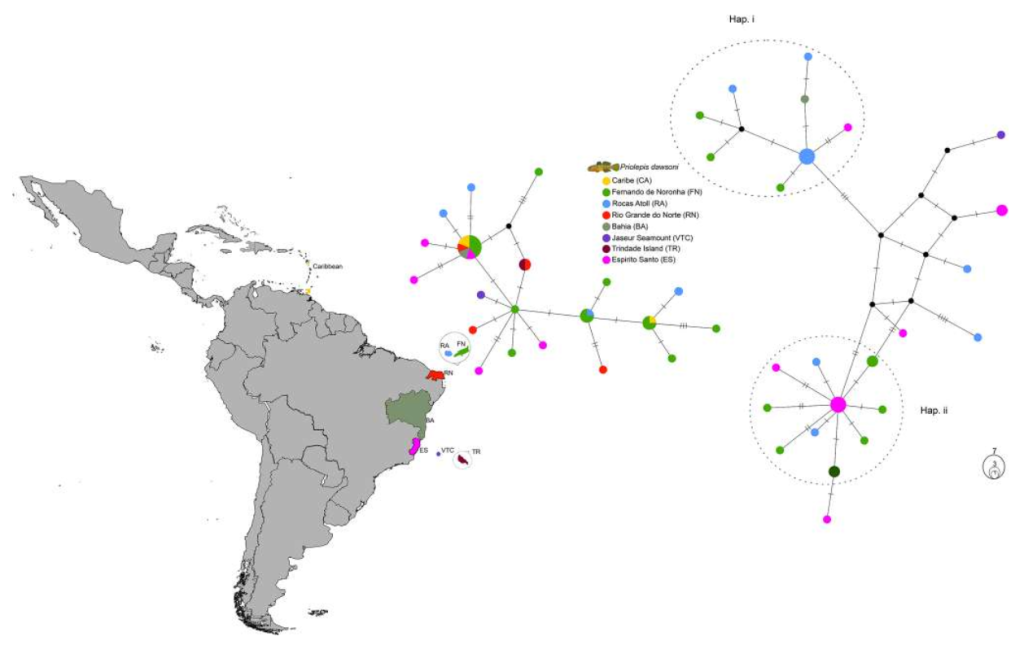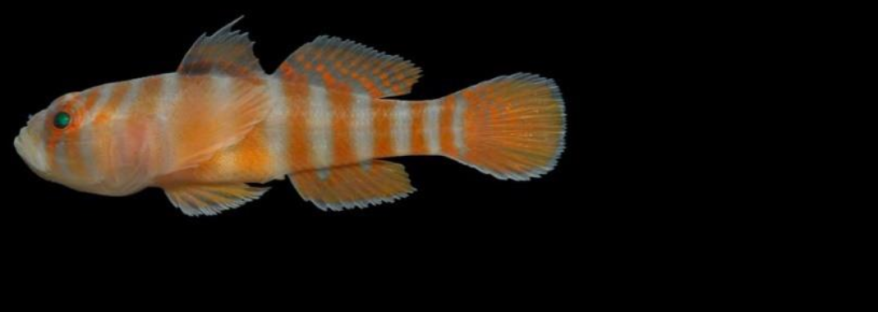Versão em português abaixo
The UFES Ichthyological Collection (CIUFES) has a relevant collection of cryptobenthic marine fishes from the Brazilian coast and oceanic islands. This collection, besides including numerous paratypes and holotypes, allows clarifying the often complex evolutionary history of these little-known species. In the present work, Thais Quintão presents to the scientific community the results of her master’s degree by establishing how Priolepis – a circumtropical genus – colonized and speciated in the Atlantic.
Priolepis (Gobiidae) is a genus of cryptobenthic fishes with a cosmopolitan distribution in tropical oceans. In the Atlantic, it is represented by P. ascensionis, P. dawsoni, P. hipoliti, and P. robinsi. With the exception of the latter, these species have their distribution limited by known biogeographic barriers signalling allopatric origins. In the present study, we used phylogenetic/phylogeographic approaches to uncover the evolutionary history of Priolepis in the Atlantic by testing three hypotheses: (i) The closure of the Tethyan Passage gave rise to a monophyletic Atlantic lineage; (ii) The formation of the Amazon Barrier divided the species into southwestern and northwestern Atlantic lineages; and (iii) Dispersal from Brazil across the Mid-Atlantic Barrier gave rise to the Santa Helena and Ascension Islands lineage.

Neither hypothesis was refuted by our results. Phylogenies recovered the monophyly of the Atlantic Priolepis clade and its isolation from the Western Indian/ Pacific Ocean ~ 16.9 million years ago. A few million years later (14-10 Mya), the emergence of the Amazon Barrier divided Priolepis into a southwestern and a northwestern ancestral. The closure of the Isthmus of Panama, as well as Pliocene and Pleistocene climatic variations, had an important influence on the formation of the different lineages within P. dawsoni, and P. hipoliti. During the Pleistocene, the occupation of the Vitoria-Trindade chain may have favored dispersal to the Mid-Atlantic islands, influencing the origin of P. ascensionis. Our results also highlight the great ability of P. dawsoni and P. hipoliti to maintain connectivity between remote areas and different habitats, a singular pattern among Brazilian cryptobenthic fishes.


Check it out in our Published papers!
A história evolutiva de Priolepis (Gobiidae) no Oceano Atlântico

A Coleção Ictiológica da UFES (CIUFES) tem relevante acervo de peixes marinhos criptobênticos da costa e das ilhas oceânicas brasileiras. Este acervo, além de contemplar numerosos parátipos e holótipos, permite esclarecer a história evolutiva, frequentemente complexa, destas espécies pouco conhecidas. No presente trabalho, a doutoranda Thais Quintão apresenta à comunidade científica os resultados do seu mestrado ao estabelecer como Priolepis – um gênero circuntropical – colonizou e se especiou no Atlântico.
Priolepis (Gobiidae) é um gênero de peixes criptobênticos com distribuição cosmopolita nos oceanos tropicais. No Atlântico, é representado por P. ascensionis, P. dawsoni, P. hipoliti e P. robinsi. Com a exceção da última, estas espécies têm as suas distribuições limitadas por barreiras biogeográficas conhecidas, o que sinaliza uma origem alopátrica para as diversas espécies. No presente estudo, utilizamos abordagens filogenéticas/filogeográficas para descobrir a história evolutiva de Priolepis no Atlântico testando três hipóteses: (i) o fechamento da passagem do mar de Tethys deu origem a uma linhagem atlântica monofilética; (ii) a formação da barreira amazônica dividiu a espécie em linhagens distintas ao sudoeste e noroeste do Atlântico oeste; e (iii) a dispersão do Brasil para as ilhas de Santa Helena e Ascensão através da barreira centro-atlântica deu origem à linhagem do Atlântico central. Nenhuma das hipóteses foi refutada. As filogenias recuperaram a monofilia do clado Priolepis no Atlântico e o seu isolamento do oceano Índico ocidental/Pacífico há, aproximadamente, 16,9 milhões de anos atrás. Alguns milhões de anos mais tarde (14-10 Mya), a emergência da barreira amazônica dividiu Priolepis em duas linhagens na costa oeste do Atlântico. O fechamento do istmo do Panamá, bem como as variações climáticas do Plioceno e do Pleistoceno, teve uma importante influência na formação das diferentes linhagens dentro de P. dawsoni e P. hipoliti. Durante o Pleistoceno, a ocupação da cadeia Vitoria-Trindade pode ter favorecido a dispersão para as ilhas mesoatlânticas, influenciando a origem de P. ascensionis. Os nossos resultados também realçam a grande capacidade de P. dawsoni e P. hipoliti para manter a conectividade entre áreas remotas e diferentes habitats, um padrão singular entre peixes criptobênticos brasileiros.
Confira na nossa página de Artigos publicados!

